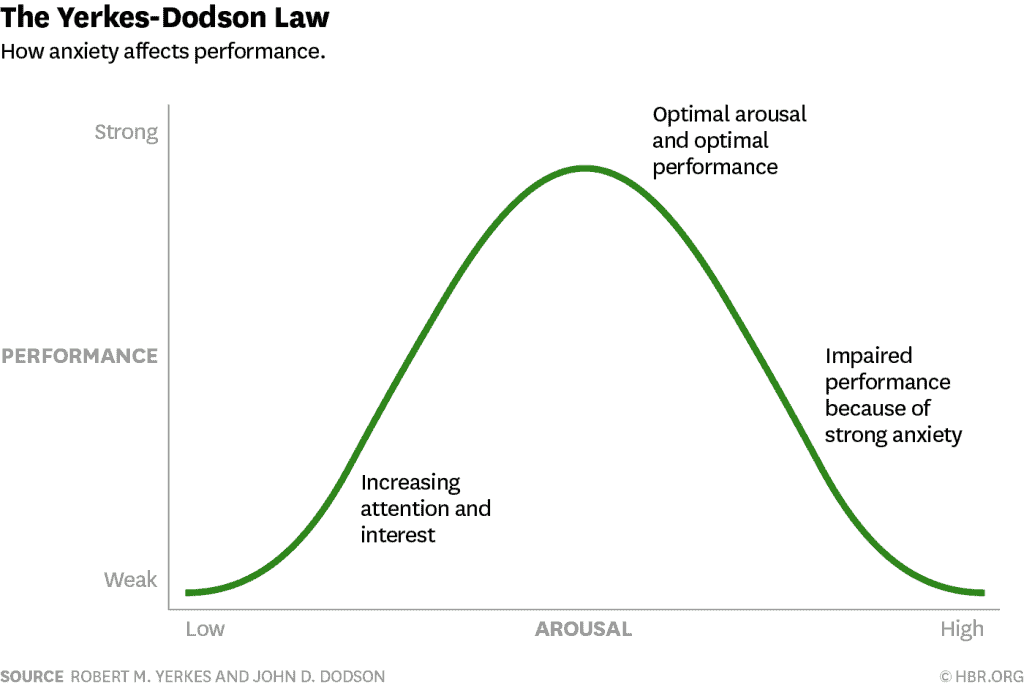The 4 S approach
To talk about solutions, let’s use this easy-to-remember acronym called the 4 S approach: Stress, Structure, Support, Success.
Stress
First and foremost, stress. I like to commonly refer to the stress/performance curve to show that some stress is okay, but too much stress can be detrimental. On the other hand, not enough stress can also cause issues related to performance of the individual. Managing this sweet spot can be tricky and takes attention to the right indicators in order to manage effectively.
There are clear impacts of this curve taking place on the leader themselves; however, another important consideration is the impact this could have on the 20 or 30 employees who rely on him; for example, studies have shown that the manager’s stress level has an impact on their employees’ physical and mental health. The very first step that must be taken is to align the stress level with peak performance. A few key initiatives senior leadership teams can take to achieve this:
- Communication, Recognition, and Understanding of the sources of the stress. Hold a workshop, a brainstorm, or a questionnaire to better understand and listen closely.
- Build in a support structure. It is easy to temporarily bring stress down through a single meeting but to maintain optimal performance levels consistently, stress must be managed regularly with support; knowing that you have regular and structured support from your managers, coaches, and colleagues will open up the lines of communication.
- Walk the talk, immediately! Bring some quick wins to the table and show your commitment to addressing areas where you can quickly make an impact.
Structure
Once we have created an environment that will foster development and performance, , we can examine the technical aspect of what it looks like. Many organizations have answered this call by implementing Leader Standard Work (LSW) which is a well-designed yet still a theoretical image of how a leader’s day/week should play out. This is a great first step into structuring a front-line manager’s time, but it needs to be backed up with the support to achieve it. This support must come from their direct manager and other coaches within the organization who understand the distractions that pull attention away from their LSW.
Support
Lastly, a re-prioritization of activities that will proactively address issues prior to them occurring and thus limit the number of unplanned interruptions to their LSW . As we would say in maintenance, if you want your equipment to stop breaking down unexpectedly, you need to have a better PM (preventive maintenance) program. The same goes for leaders. In order to have fewer unexpected interruptions throughout the day, you must engage in activities that serve to anticipate and fix these in a controlled and planned way. Leadership must build in the time and space for our front-line leaders to engage in these activities and play an active role in helping them to prioritize key events like structured floor tours and performance dialogues with their team.
Success
It is critical to quantify the gains made by the leader in achieving all of the above, including stress. Regularly monitoring the manager’s progress in all three of the above categories is important. Furthermore, the responsibility for these results must be held not only by the leader himself, but also shared by the coaches who support him and his direct superior. In doing so, the burden of development is shared, and a greater overall success is ensured.
To recap on our key points, front-line leaders within each organization face huge challenges. In many cases, these challenges cause performance issues which are translated onto the team and may prevent the operation from reaching its full potential. To ensure the success of front-line managers, as well as the organization’s, these challenges may be addressed by using the 4 S Approach: Stress, Structure, Support, Success.
Frontline managers really are unsung heroes! Let us give them gratitude.
When it comes to a company's performance, rock-solid yet agile management is the very foundation of any success. Proaction International's experts can help your teams develop their leadership to support your organization's growth.









